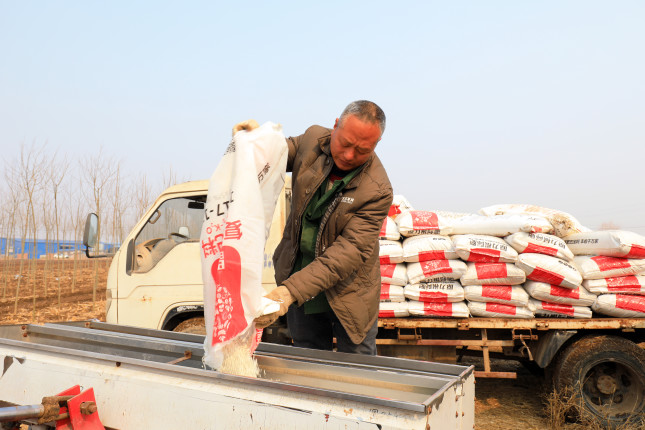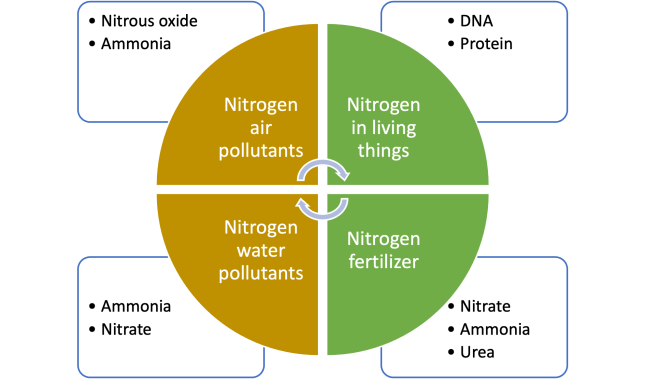During the November COP27 climate talks in Egypt, Presidents Xi and Biden agreed to restart bilateral climate talks that would build on the clean energy and the green and climate-resilient agriculture priorities highlighted in the U.S.-China Climate Crisis Statement and the U.S.-China Glasgow Declaration. While details remain to be ironed out, the renewed dialogue could open up a new area of collaboration around greenhouse gas emissions from food production, targeting an oft-overlooked long-lived climate pollutant, nitrous oxide (N2O).
Decisions that farmers and government officials make – sometimes with good intentions – result in nitrogen escaping the agricultural landscape to create algal blooms and emit greenhouse gases. In the United States, 79 percent of nitrous oxide emissions come from agriculture. Nitrous oxide emissions from China’s agriculture in 2008 accounted for 74 percent of all the country’s N2O emissions.
Many of us learned in U.S. schools how the Native Americans taught the Pilgrims to grow corn. They buried a small fish with the corn seed to provide nitrogen fertilizer to the growing plant. At the same time Pilgrims settled in America in 1620, Chinese farmers were collecting nitrogen for fertilizer found in soybean cake, animal manure, and even human night soil hauled from the cities for their crops. These early farmers knew that soil, water, and sunshine were not enough to grow food. Nitrogen was essential for survival.
“You can have too much of a good thing” is a lesson that can be applied to nitrogen. While life on earth cannot exist without it as a building block of every cell’s DNA and the proteins that regulate biological processes in every living thing, too much nitrogen in agricultural soil becomes an air and water pollutant. One of those pollutants is nitrous oxide, a powerful, long-lived greenhouse gas that is 300 times stronger than CO2that persists in the atmosphere for 120 years.
Both the United States and China are top food producers. China ranks as the world’s largest grain producer. The United States is considered a food market superpower, as well as the world’s largest food exporter. With their position of leadership in food production, and a new agreement at COP27 in Egypt to restart climate dialogues, China and the United States are well situated to lead efforts in green agriculture to address climate change.
The many faces of nitrogen
It was the “Green Revolution,” which was first funded in the 1950s by the Ford and Rockefeller Foundations, and then supported by government agencies, that sought to feed the world. U.S. scientist Norman Borlaug (who won the Nobel Prize) and China’s Yuan Longping (who won the World Food Prize) both promoted the use of chemical fertilizer to increase yield and save millions of people from starvation. The introduction of nitrogen fertilizer increased farmer income and reduced the backbreaking labor of collecting and hauling sewage and manure for fertilizer. Sadly, it is this heavily promoted agricultural practice that also moved nitrogen from being a fertilizer to an air, water, and climate pollutant.
Nitrogen is the most important input a farmer can control to increase yield. Because it is relatively inexpensive, it is tempting to add just a little extra. Only about 35 percent of U.S. crops receive nitrogen at the right rate, time, and placement. In China, the overuse rate for chemical fertilizer varies by crop and region — but overall, it exceeds 50 percent.
Nitrogen does not start out as a greenhouse gas. Excess nitrogen is transformed through a natural process in wet soil from a fertilizer to nitrous oxide, which is a greenhouse gas. Rice, grown in flooded fields, emits both methane and nitrous oxide. It is estimated that global emissions from rice production equal the warming impact of 600 coal plants.
Nitrogen is part of every living thing, so it must be in the soil for plants to grow. Some plants have the unique ability to extract nitrogen right from the air. Nitrogen-fixing plants like soybeans, peanuts, clover, and alfalfa, even enrich the soil, leaving behind nitrogen for other plants. Most plants, however, need fertilizer to grow. So, for centuries, farmers hauled manure and compost to spread on their fields to provide the essential nitrogen.
According to Dr. Hongmin Dong, a researcher and Deputy Director General at the Chinese Academy of Agricultural Sciences, manure application not only adds organic matter and improves soil properties, but it also replaces chemical fertilizer. Her research also underscored the importance of the way manure is handled and applied. Because manure contains a lot of nitrogen, injecting liquid manure into the soil will reduce odors and nutrient runoff, but it also can increase nitrous oxide emissions.

Figure created by and used with permission courtesy of the author, Karen Mancl.
Policy impacts
The United States is the fourth largest producer of nitrogen fertilizer, producing enough to satisfy most of the domestic demand. To better manage nitrogen to reduce loss, the USDA provides financial and technical assistance to farmers to develop nutrient management plans. The voluntary 4R Nutrient Stewardship Program, first developed and promoted by The Fertilizer Institute, provides a framework for better fertilizer management. Farmers are expected to match their crop needs with those four Rs: the Right source, at the Right rate, at the Right time, and in the Right place.
The voluntary 4R nutrient stewardship program, started by industry, has catalyzed a diverse group of interests to work together on the question. Mark Fritz, 4R Outreach Coordinator of the Ohio AgriBusiness Association, observes that the supporters in the effort range from The Nature Conservancy and state environmental regulators to his state’s Farm Bureau. Unfortunately, the current policy of financial and technical assistance for nutrient management is not yet adequate. In the United States, an estimated 108 million acres need improved nitrogen management, an area about the size of California.
China is the biggest user of nitrogen fertilizer, currently consuming one-third of the global total. This practice enables China to be food self-sufficient. China also has the largest nitrogen fertilizer industry, uniquely using coal to produce much of its fertilizer. Nitrogen fertilizer has been subsidized in China since 2006, which has resulted in its overuse in the nation’s agriculture.
Agricultural emissions were added to the Chinese Clean Air Act in 2018. Then, in 2020, a new regulation — Zero Increase in Chemical Fertilizer Use — was introduced. China’s agricultural sector is huge, with 200 million small farms, most less than an acre. The sector is also diverse, decentralized, and unorganized, with limited educational support and little regulation. China’s agricultural extension is a part of the government’s Ministry of Agriculture and Rural Affairs, but, historically, this educational program for farmers has not included an environmental mandate. The 4R Nutrient Stewardship concept used in the United States also has been promoted in China, but the very small sizes of Chinese farms make implementation impractical.
Calls to fix the world’s nitrogen problem and make the green revolution truly green are getting louder. Neither the United States nor China has a model policy to reduce nitrous oxide emissions. Following their joint climate crisis statement at the Glasgow Summit and the bilateral agreement at COP27, the two countries’ agricultural scientists and policymakers may now have an opportunity to work together to reduce emissions of the extremely powerful nitrous oxide greenhouse gas.
Karen Mancl is a Professor of Food, Agricultural and Biological Engineering at The Ohio State University and is the Director of the OSU Soil Environment Technology Learning Lab. She holds a PhD in Water Resources from Iowa State University, an MA in East Asian Studies and an MA in Public Policy from Ohio State University.
Sources: American Historical Review, American Society for Horticultural Science, Climate Home News, Duke Sanford, EDF, Farmdoc Daily, GOV.CN, Investopedia, Journal of Cleaner Production, Late Imperial China, Nature, Oklahoma State University, Philosophical Transactions of the Royal Society A, Sustainability, The Fertilizer Institute, University of California, USDA, U.S. Department of State, US EPA, World Bank
Lead Image Credit: A farmer adding fertilizer to the planter in a field in Luannan County in Hebei Province, China, courtesy of chinahbzyg/Shutterstock.com.

 A Publication of the Stimson Center.
A Publication of the Stimson Center.





